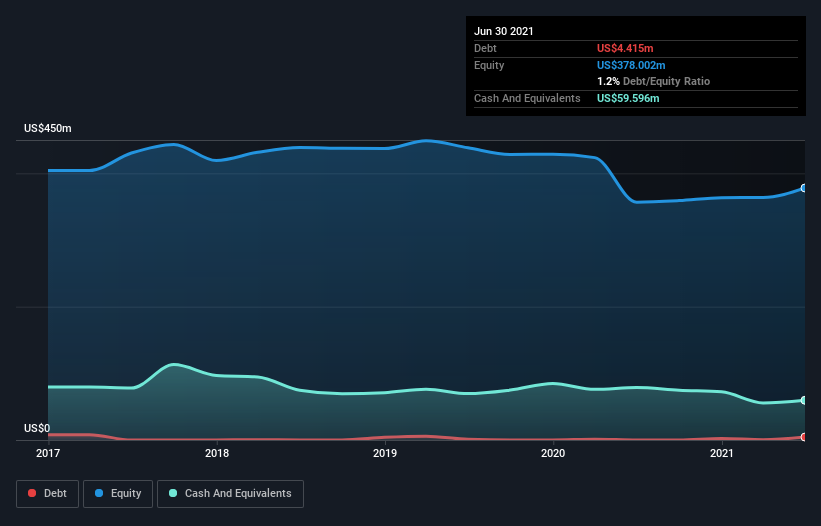We Think Neo Performance Materials (TSE:NEO) Can Manage Its Debt With Ease
The external fund manager backed by Berkshire Hathaway's Charlie Munger, Li Lu, makes no bones about it when he says 'The biggest investment risk is not the volatility of prices, but whether you will suffer a permanent loss of capital.' So it might be obvious that you need to consider debt, when you think about how risky any given stock is, because too much debt can sink a company. Importantly, Neo Performance Materials Inc. (TSE:NEO) does carry debt. But the more important question is: how much risk is that debt creating?
When Is Debt A Problem?
Generally speaking, debt only becomes a real problem when a company can't easily pay it off, either by raising capital or with its own cash flow. Ultimately, if the company can't fulfill its legal obligations to repay debt, shareholders could walk away with nothing. However, a more common (but still painful) scenario is that it has to raise new equity capital at a low price, thus permanently diluting shareholders. Having said that, the most common situation is where a company manages its debt reasonably well - and to its own advantage. When we examine debt levels, we first consider both cash and debt levels, together.
View our latest analysis for Neo Performance Materials
What Is Neo Performance Materials's Net Debt?
You can click the graphic below for the historical numbers, but it shows that as of June 2021 Neo Performance Materials had US$4.42m of debt, an increase on none, over one year. But on the other hand it also has US$59.6m in cash, leading to a US$55.2m net cash position.
A Look At Neo Performance Materials' Liabilities
We can see from the most recent balance sheet that Neo Performance Materials had liabilities of US$86.2m falling due within a year, and liabilities of US$34.8m due beyond that. On the other hand, it had cash of US$59.6m and US$70.8m worth of receivables due within a year. So it can boast US$9.44m more liquid assets than total liabilities.
This state of affairs indicates that Neo Performance Materials' balance sheet looks quite solid, as its total liabilities are just about equal to its liquid assets. So while it's hard to imagine that the US$611.2m company is struggling for cash, we still think it's worth monitoring its balance sheet. Succinctly put, Neo Performance Materials boasts net cash, so it's fair to say it does not have a heavy debt load!
Even more impressive was the fact that Neo Performance Materials grew its EBIT by 176% over twelve months. If maintained that growth will make the debt even more manageable in the years ahead. When analysing debt levels, the balance sheet is the obvious place to start. But it is future earnings, more than anything, that will determine Neo Performance Materials's ability to maintain a healthy balance sheet going forward. So if you're focused on the future you can check out this free report showing analyst profit forecasts.
Finally, a company can only pay off debt with cold hard cash, not accounting profits. While Neo Performance Materials has net cash on its balance sheet, it's still worth taking a look at its ability to convert earnings before interest and tax (EBIT) to free cash flow, to help us understand how quickly it is building (or eroding) that cash balance. During the last three years, Neo Performance Materials produced sturdy free cash flow equating to 51% of its EBIT, about what we'd expect. This free cash flow puts the company in a good position to pay down debt, when appropriate.
Summing up
While we empathize with investors who find debt concerning, you should keep in mind that Neo Performance Materials has net cash of US$55.2m, as well as more liquid assets than liabilities. And it impressed us with its EBIT growth of 176% over the last year. So we don't think Neo Performance Materials's use of debt is risky. There's no doubt that we learn most about debt from the balance sheet. But ultimately, every company can contain risks that exist outside of the balance sheet. For example - Neo Performance Materials has 2 warning signs we think you should be aware of.
If you're interested in investing in businesses that can grow profits without the burden of debt, then check out this free list of growing businesses that have net cash on the balance sheet.
This article by Simply Wall St is general in nature. We provide commentary based on historical data and analyst forecasts only using an unbiased methodology and our articles are not intended to be financial advice. It does not constitute a recommendation to buy or sell any stock, and does not take account of your objectives, or your financial situation. We aim to bring you long-term focused analysis driven by fundamental data. Note that our analysis may not factor in the latest price-sensitive company announcements or qualitative material. Simply Wall St has no position in any stocks mentioned.
Have feedback on this article? Concerned about the content? Get in touch with us directly. Alternatively, email editorial-team (at) simplywallst.com.

 Yahoo Finance
Yahoo Finance 
